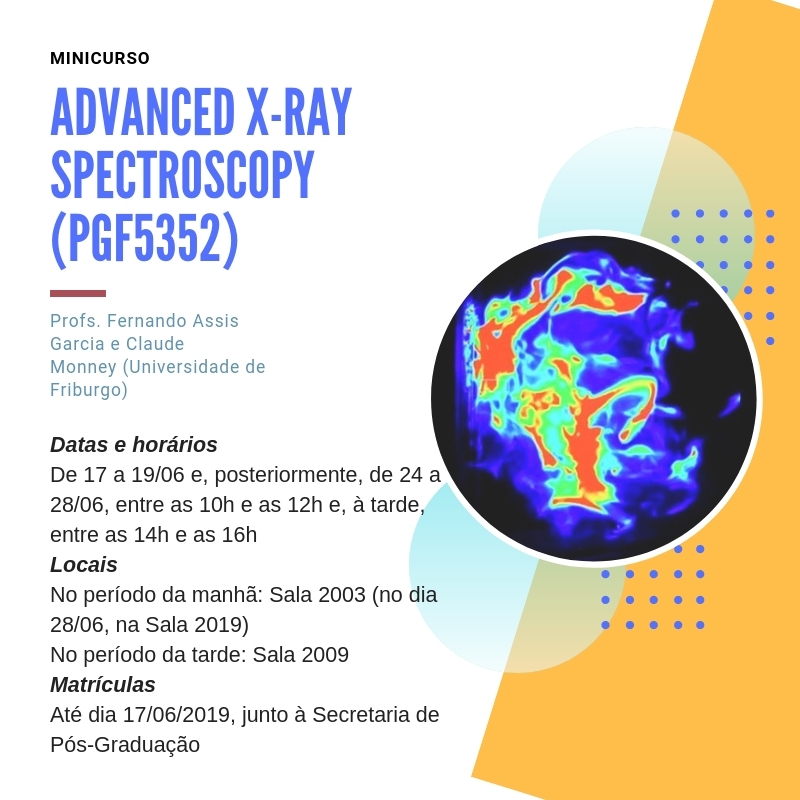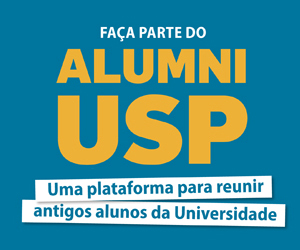
Estão abertas as matrículas para o minicurso PGF5352 - Advanced x-ray spectroscopy que vale 2 créditos no histórico acadêmico. A disciplina tem duração de 2 semanas: na primeira, as aulas serão ministradas pelo Prof. Fernando Garcia; na segunda, serão conduzidas pelo Prof. Claude Monney, da Universidade de Friburgo (Suíça), especialista em física da matéria condensada.
Alunos que não têm vínculo com o nosso programa podem se inscrever como alunos especiais mediante a apresentação de alguns documentos; clique aqui para ver quais são.
Veja, abaixo, o programa fornecido pelos professores (lembrando que o minicurso será oferecido em inglês).
Objective
In this course, we intend to provide an in depth training on advanced x-ray spectroscopy, with an emphasis on the fundamentals of synchrotron based experiments. We will start discussing the radiation matter interaction and will develop the topics related to several x-ray based experimental techniques, such as x-ray absorption spectroscopy (XAS), Angular Resolves Photoemission Spectroscopy (ARPES) and resonant inelastic scattering (RIXS). By the end of this course we expect that the student will be able to: (1) understand the outcome of several experiments based on the x-ray absorption and scattering; (2) perform data analysis of simple absorption and scattering data (qualitative and quantitative methods); (3) understand the specifics of synchrotron based experiment and write a preliminary experimental proposal.
Prerequistes: formally none. You better know: quantum mechanical perturbation theory (2nd order) and elementary scattering theory (born approximation). Good reference is: Sakurai’s Modern Quantum Mechanics, Chapters 5 (5.5 and 5.7) and 7 (7.1 and 7.2). We will review it.
Justification
X-ray based spectroscopy are employed in a variety of topical studies in material sciences, condensed matter physics, chemistry, etc. with the advent of the SIRIUS light source in Brazil, we must work to the expansion of our x-ray community. This course is devoted to introduce graduate students to advanced synchrotron based techniques. The subjects are connected to the experimental capabilities that will be available on two SIRIUS beamlines to be implemented in the first phase of the project: the IPÊ (RIXS and ARPES) and EMA (hard X-ray spectroscopy at extreme conditions) beamlines.
Course content
X-ray absorption spectroscopy, photoemission spectroscopy, angle-resolved photoemission spectroscopy, resonant inelastic x-ray scattering.
Details: https://sites.google.com/site/ferton/home (class notes, lecture by lecture, etc).
Grading (mandatory activities, in English)
(1) Paper essay/seminar (50%): a short seminar (or essay) about a paper of choice by the student (there will be a list and a guide); (2) a synchrotron proposal (50%): a two page document where you will propose a synchrotron based experiment applying one of the techniques discussed in the course.
Program - First Week (17–19): Prof. Fernando Garcia (IFUSP)
XAS and PES processes: In this second lecture, we will give a more solid approach to the subject. The first order time-dependent perturbation theory (a.k.a Fermi’s Golden rule) is reviewed and the dipole rules for XAS and PES are deduced. We shall exemplify the theory approaching some specifics of transition metal physics. Afternoon, we shall discuss results from recent literature in the area learning how to extract useful information from these experiments.
Survey of solid state physics concepts: we will offer a fast paced survey of the following concepts - lattices, reciprocal lattices and electronic structure (we shall explore the square lattice, morning) and elementary excitations. This last topic will be approached with a tutorial to the application of second quantization formalism.
Basics of ARPES: the first lecture is devoted to the basics of angle-resolved photoemission spectroscopy (ARPES), which is the most employed technique to access the momentum-resolved electronic structure of materials. We will learn how the photoelectric effect is used to perform photoemission spectroscopy. We will also learn how to take advantage of the conservation of momentum to perform ARPES.
The spectral function in ARPES: this lecture will introduce the concept of the spectral function in photoemission. We will learn under which conditions we can model photoemission with the spectral function and will derive together relevant formulas. We will then see what information about many body physics is encoded in the spectral function.
The spectral function in ARPES 2: this lecture is a follow-up of the previous one. We will study famous examples from the scientific literature to illustrate how ARPES can access many body effects in correlated materials and how it can be modelled through the spectral function. Typically we will discuss together the effect of electron-phonon coupling or electron-electron interactions in ARPES.
Basics of RIXS: this lecture is devoted to the basics of resonant inelastic x-ray scattering (RIXS). RIXS is a powerful and versatile x-ray spectroscopy. We will derive together the Kramers-Heisenberg formula describing RIXS using second-order perturbation theory. We will then discuss how a RIXS experiment is planned in practice, taking advantage of the absorption edge of relevant ions in materials and of the scattering geometry.
RIXS on correlated materials: in the last 10 years, the development of the RIXS technique and its application to correlated materials followed a steady and impressive development. We will illustrate this with examples from the scientific literature and discuss them in details. We show how RIXS can measure crystal field excitations, magnetic excitations or interband electron-hole excitations. We will discuss how one can take advantage of the RIXS cross-section to discriminate between these different excitations.









